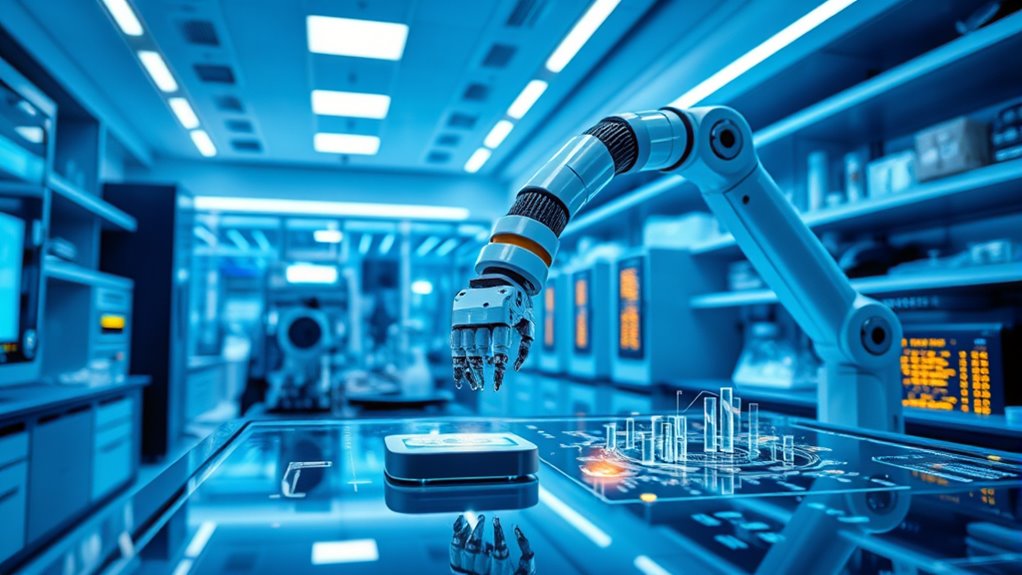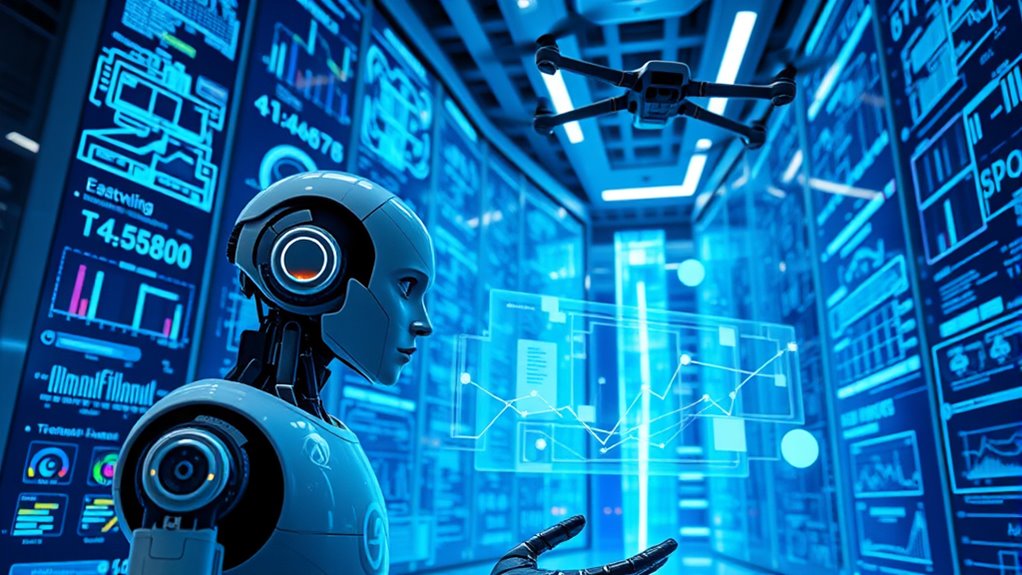Machines are now capable of creating knowledge through autonomous science, which allows systems to design experiments, analyze results, and generate hypotheses independently. These intelligent systems sense their environment, make decisions, and learn from each experiment, speeding up discoveries across fields like material design and drug development. With advanced AI, robotics, and quantum tech, autonomous exploration is transforming research. If you keep exploring, you’ll uncover how these technological advances are shaping the future of scientific discovery.
Key Takeaways
- Autonomous science enables machines to conduct experiments, analyze data, and generate hypotheses independently, accelerating discovery processes.
- Cutting-edge AI and quantum technologies facilitate high-throughput research and real-time decision-making in scientific labs.
- These systems operate in self-governing, closed-loop cycles, learning from each experiment to refine their understanding.
- Autonomous research reduces human intervention, increasing efficiency, reproducibility, and the ability to explore complex scientific questions.
- Challenges include integrating legacy lab processes, building trust, and developing adaptable infrastructures for broader adoption.
Understanding Autonomous Science and Its Key Traits

Autonomous science represents a revolutionary shift in how scientific discovery occurs, as machines now carry out complex research processes with minimal human input. These systems can sense their environment, gather data through sensors, cameras, or instruments, and analyze this information independently. They make decisions, generate hypotheses, and select experiments using advanced AI algorithms, all while adapting to new data in real time. Self-governance allows them to control experimental protocols, handle errors, and refine their approach without human oversight. They operate in closed-loop cycles, continuously learning from each experiment to improve future actions. Unlike simple automation, autonomous science systems exhibit flexible, goal-directed reasoning, enabling them to conduct sophisticated research tasks and accelerate discoveries across various scientific fields. These systems are designed to operate independently without constant supervision, which is a key characteristic of autonomous systems. Additionally, their ability to minimize human intervention allows for faster iteration and discovery in complex experiments.
Cutting-Edge Applications Transforming Research Fields

Recent advances in autonomous science are transforming various research fields through innovative applications that leverage AI and robotics. In materials science, autonomous experiments and self-driving labs accelerate discovery by automating sample handling and data collection, enabling the synthesis of new materials like solid-state lasers. Machine learning, combined with robotics, supports high-throughput experiments, generating extensive datasets and uncovering novel insights. This automation is reshaping the industry pipeline, making materials development more scalable for industrial applications. The integration of robotic automation into research workflows further enhances efficiency and reproducibility, leading to faster development cycles. In quantum computing, companies like Google and Microsoft push toward commercial solutions, promising breakthroughs in drug discovery and materials optimization once scalability challenges are addressed. These applications are revolutionizing research, speeding up discovery processes, and bridging the gap between laboratory innovation and real-world impact. Quantum computing’s emerging role in simulating complex molecules is further enhancing the potential for rapid scientific breakthroughs across disciplines.
Technologies Powering Self-Directed Scientific Exploration

Technologies like AI-driven experimental design, quantum and neuromorphic computing, edge computing, IoT, and AutoML are revolutionizing how scientists explore and understand complex phenomena. AI models like GPT-4.5 automate hypothesis generation, synthesizing vast data to identify promising research directions rapidly. They reduce inference costs, enabling faster experiment iteration and refinement. Quantum and neuromorphic computing offer enhanced simulation capabilities, with quantum reducing error rates and neuromorphic providing efficient pattern recognition, supporting real-time analysis. Edge computing and IoT facilitate in-situ data processing, allowing experiments to adapt instantly based on environmental feedback. AutoML automates model development, speeding hypothesis testing and making AI accessible across disciplines. This integrated approach is accelerating discovery in fields such as defense technology development, where rapid innovation is critical. These technologies collectively empower autonomous systems to conduct scientific research more efficiently, accurately, and with minimal human intervention. Additionally, ongoing advancements in autonomous systems are opening new frontiers for scientific inquiry, further reducing the need for direct human oversight.
Comparing Autonomous Science With Broader Autonomous Systems

Self-directed scientific exploration shares many features with autonomous systems used across other sectors, such as transportation and manufacturing. Both rely heavily on sensors to gather data and AI to analyze it, enabling real-time decision-making. These systems operate along a spectrum of autonomy, from fully autonomous to supervised, depending on the application. In science, autonomous systems adapt to new data and explore complex tasks independently, similar to their counterparts in other fields. They also utilize machine learning and adaptive algorithms to handle unexpected situations. While the core technologies overlap, autonomous science emphasizes dynamic research processes, risk management, and exploration of new frontiers. Overall, autonomous science extends the principles of broader autonomous systems into the domain of discovery, pushing the boundaries of what machines can achieve. Autonomous systems often use advanced AI and robotics to perform complex tasks without human intervention.
Navigating Challenges and Exploring Future Opportunities

Bridging the “valley of death” in autonomous science requires overcoming significant hurdles that prevent lab discoveries from scaling up and becoming practically deployable. You face challenges like existing lab processes optimized for humans, which slow down autonomous workflows. To succeed, you need to develop new AI reward functions emphasizing cost and manufacturability, not just scientific metrics. Moving from decades-long discovery to a unified, rapid process is essential. You must also create modular infrastructures to overcome legacy equipment limitations. Here’s a snapshot of key areas:
| Challenge | Opportunity |
|---|---|
| Data complexity | Implement real-time decision-making |
| Legacy equipment | Standardize and modularize workflows |
| Safety & validation | Build trust through continuous validation |
Addressing these hurdles opens the door to more efficient, impactful autonomous science. Incorporating diverse and innovative designs for lab equipment can further enhance adaptability and efficiency in autonomous workflows.
Frequently Asked Questions
How Do Autonomous Science Systems Ensure Data Security and Privacy?
You can guarantee data security and privacy in autonomous science systems by implementing data masking and anonymization techniques, which scramble sensitive information while preserving utility. You should also enforce access controls like RBAC and MFA, making sure only authorized users access data. Autonomous threat detection and adaptive defenses monitor vulnerabilities in real-time, while normative frameworks define clear privacy policies, ensuring the system complies with regulations and protects sensitive information at all times.
What Are the Ethical Considerations Specific to Autonomous Scientific Discoveries?
You need to think about the ethical implications of autonomous scientific discoveries, such as transparency, accountability, and bias. Make sure the systems are explainable so you understand how results are generated. Be aware of potential biases that could skew findings or harm marginalized groups. Maintain responsibility for the technology’s outcomes, and promote fairness and social justice. Protect privacy by handling data responsibly, obtaining consent, and safeguarding sensitive information throughout the research process.
How Do Autonomous Systems Handle Unexpected Experimental Failures?
Like a seasoned detective, you see that autonomous systems recognize and respond to unexpected experimental failures swiftly. They monitor sensors and actuators, compensating for issues through fault-tolerant design, just as a vigilant guard maintains security. By predicting failures ahead of time with high accuracy and using distributed control, they maintain performance under uncertainty. This proactive approach guarantees safety, reliability, and continuous operation, even when surprises threaten the experiment’s success.
Can Autonomous Science Replace Human Scientists Entirely?
Autonomous science can’t fully replace human scientists yet. While AI can process data and run experiments efficiently, it lacks human creativity, ethical reasoning, and emotional intelligence. You need human insight to interpret complex data, generate novel ideas, and navigate unpredictable situations. Collaborating with AI enhances your capabilities, but relying solely on autonomous systems ignores the nuanced judgment and interdisciplinary understanding that humans bring to science.
What Skills Are Needed to Develop and Maintain Autonomous Research Platforms?
You become the captain steering a ship through uncharted waters, requiring a blend of skills to develop and maintain autonomous research platforms. You need programming expertise in Python, C++, and MATLAB, along with knowledge of robotics, computer vision, and AI frameworks like TensorFlow. Control systems, sensor fusion, and data analysis skills maintain your vessel steady. Strong project management and collaboration ensure your ship stays on course in the ever-evolving autonomous research landscape.
Conclusion
As you explore autonomous science, imagine a machine independently discovering a new material that revolutionizes energy storage. This shows how your future could be shaped by systems that learn, adapt, and innovate without human input. Embracing these technologies opens doors to faster breakthroughs and solutions to complex problems. While challenges remain, your role will be crucial in guiding ethical development and application, ensuring these intelligent systems serve humanity’s best interests.









